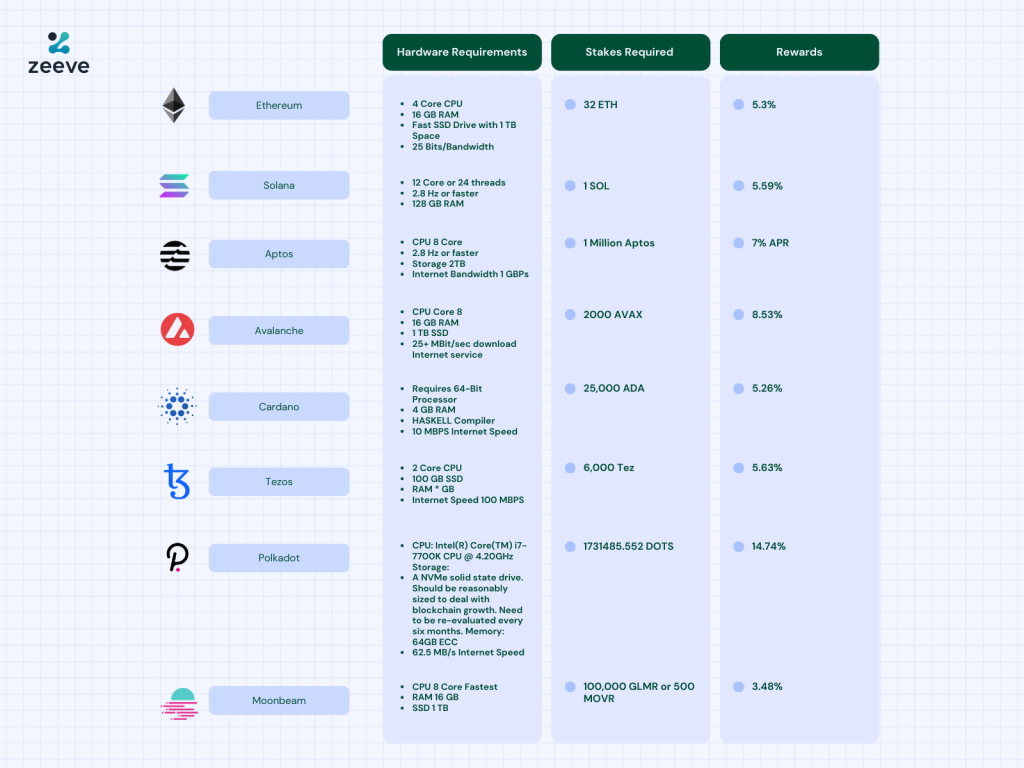In the fast-paced world of crypto investing, where risk assessment is paramount for everyone, traditional approaches like farming, lending, borrowing, or engaging with multiple DeFi platforms may not fit into institutions’ investment thesis. For those seeking a secure yet lucrative path to navigate the digital asset investment landscape, running validator nodes stands as an enticing frontier.
By delving into the intricacies of these nodes, we will explore how validator nodes work, the specific requirements to run them, and the potential rewards they offer. we will delve into how validator nodes distinguish themselves from full nodes, uncovering their unique roles in securing blockchain networks. In the end, we will see how one can get their validator nodes up and running in less than 5 minutes, skipping all the complexities.
So, without further ado, let’s get straight into it.
Read: How Do Different Blockchain Nodes Really Work? — Beyond the Blocks: Different Types of Nodes in Blockchain Networks
What is a Validator Node?
A validator node is a participant in the network that has the role of validating and relaying transactions. Validators are fundamental to the functioning and security of a blockchain network.
While the specific roles and responsibilities of validator nodes can vary depending on the specific blockchain protocol, they perform the following functions:
- Transaction Validation: Validators review and verify the authenticity of transactions that are to be added to the blockchain. This includes checking the cryptographic signatures and ensuring the transactions are properly formed according to the protocol rules.
- Block Creation/Proposal: In some blockchain networks, validators are responsible for creating or proposing new blocks of transactions. This involves gathering a set of valid transactions, forming them into a block, and proposing that block to the rest of the network.
- Consensus Participation: After a block has been proposed, the network must agree on whether to accept it and add it to the blockchain. Validators participate in this process by following the rules of the consensus mechanism to agree or disagree with the proposed block.
- Network Security: By fulfilling the above roles, validators contribute to the security of the blockchain network. They help to prevent double spending, ensure that only valid transactions are added to the blockchain, and contribute to the immutability of the ledger.
Being a validator often requires meeting certain requirements. For instance, you may need to hold and be willing to “stake” a certain amount of the blockchain’s native token. This stake is a security deposit, incentivizing honest behavior and disincentivizing malicious actions. If a validator acts dishonestly or fails to fulfill its duties properly, it may lose part or all of its stake.
How Validator Nodes Work?
Let’s understand by taking the example of Ethereum. When a user on the Ethereum Network initiates a transaction, the transaction enters a queue to be included in the next block. Validators play a key role in this process. To become a validator, a participant is required to deposit 32 ETH into a specific contract and run three types of software: an execution client, a consensus client, and a validator client. Once set up, the validator starts receiving transactions to verify and validate.
The process begins when a user creates and signs a transaction using their private keys, typically initiated via a wallet interface. This interface communicates with the network through the JSON-RPC API, specifying the base fee and tip to be paid to the validator. The transaction is then sent to the execution client, which verifies whether the initiating user has sufficient funds for the transaction. Once confirmed, the transaction is added to the mempool and broadcast to the network nodes.
A system called RANDAO, a Random Number Generation Authority, then selects validators to validate the transaction. The transactions from the mempool are bundled into an execution payload and sent to the chosen validators for verification. This block includes details about rewards, penalties, slashings, and attestations.
After the validators receive this block, they verify it, updating the state of the blockchain. This information is then passed to the consensus layer of the network, where the transactions are re-validated to ensure their sequence. If everything checks out, the validator attests that the block is valid. This process continues in cycles, with the validator nodes continuously validating and verifying new transactions and blocks.
How Do Validator Nodes Differ from Full Nodes?
In the realm of blockchain nodes, we often hear two names: validator nodes and full nodes. While both are integral to a blockchain network, their roles, functionalities, and capabilities vary.
Let’s examine these differences:
- Roles in the Network:
Validator Nodes are run by a pre-set number of validators responsible for validating transactions. While Full Node can be run by any participant who meets the network’s entry requirements, verifying transactions and maintaining network synchronization.
- Transaction Validation:
Validator Nodes validate transactions based on the blockchain’s rules and protocols.
And Full Nodes validate transactions through synchronization with the rest of the network, ensuring blockchain-wide consensus.
- Writes and Reads:
Validator Nodes accept “writes” to the blockchain, processing and adding user transactions to the ledger. But Full Nodes primarily focus on “reads,” handling user queries and offering scalability to the validators by distributing read request loads.
- State Authentication:
Validator Nodes maintain signatures that validate the current state of the blockchain.
While Full Nodes rely on the validators’ signatures to authenticate the blockchain’s state.
Read: How Does a Full Node Really Power Blockchain? — What is a Full Node? A Detailed Guide
Running a Validator Node: The Requirements & The Rewards
When you plan to run your own validator node, there are certain hardware requirements that you should meet. Have a look at them, and you can also analyze the cost implications and the rewards to come to a conclusion about whether you wish to run the validator nodes in the first place or not.

Efficacy of Validator Nodes In the Long Run
Diversification is key to mitigating risk in your investment portfolio. Traditional means often suggest investing in bonds, which provide stable returns over a specified period. For instance, bonds from economies such as the USA, Canada, Germany, and India yield returns of 3.52%, 2.85%, 2.25%, and 7.33%, respectively. But if you’re seeking higher yields, running a validator node on certain blockchain networks can be an intriguing addition to your portfolio.
Consider AVAX, which offers an 11% reward rate – a figure that outstrips the highest returns generated by bonds in various countries. Similarly, Polkadot yields a staggering 16%, and Kusama offers 14.77%.
However, understanding the economics of running a validator node is crucial to ensure its profitability over the long run. A basic equation to compute potential returns looks like this:
ROI = Validator Rewards + Network Fees – Cost of Running a Single Validator Node
Before deciding to run a validator node; it’s essential to calculate based on this equation. Need to keep in mind the macroeconomic factors and current market conditions, too, as they can greatly affect profitability.
The economic model of validator nodes incentivizes validators to remain active, increasing their chances of receiving rewards. For instance, on Ethereum, one of the most prominent blockchains, validators have seen returns ranging from 4.6% to 10%. Since January 2022, these figures have soared to as high as 12% APY.
This might seem attractive and spark the urge to jump in and earn. But before you do, here are a few things you must consider.
How to start running a validator node without writing a single line of code?
Navigating the complexities of running multiple validator nodes across different blockchains can be a daunting task. From varying hardware requirements to security considerations, these complexities often necessitate the services of institutional staking providers.
Zeeve offers an optimal solution to these challenges, providing a non-custodial, white-labeled staking platform. This means that while Zeeve.io manages the underlying infrastructure, you retain full control over your wallet’s private keys and validator node, including delegations and commission rates as permitted by the blockchain.
In addition, Zeeve meets SOC2 Type II, ISO, and GDPR standards, offering a secure and compliant environment for your validator nodes with enterprise-grade risk mitigation, high-performance, 24/7 monitoring, and real-time data analytics.
The streamlined process allows you to deploy a validator node in as little as five minutes with just a few clicks.
Ready to launch your validator node without coding hassles? Visit our Validator Nodes page to learn more.




